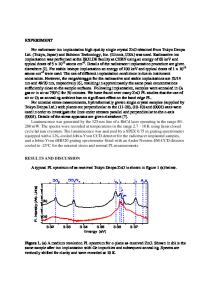Two-photon absorption induced photoluminescence in a ZnO nanostructure
- PDF / 616,312 Bytes
- 6 Pages / 612 x 792 pts (letter) Page_size
- 75 Downloads / 308 Views
1178-AA09-13
Two-photon absorption induced photoluminescence in a ZnO nanostructure Zhuo Chen1, T. Salagaj2, C. Jensen2, K. Strobl2, V. Hongpinyo3, Boon Ooi3, Mim Nakarmi1, and Kai Shum1, a 1
Physics Department, Brooklyn College of the City University of New York, 2900 Bedford Avenue, Brooklyn, NY 11210, USA 2
First Nano, a division of CVD Equipment Cooperation, 1860 Smithtown Avenue, Ronkonkoma, NY 11779, USA 3
Electrical and Computer Engineering Department, Lehigh University, Bethlehem, PA 18015, USA a
[email protected]
ABSTRACT We report on experimental results of non-resonant two-photon absorption-induced photoluminescence in ZnO nanostructures, which may act as a possible route to excite ZnO nanostructure based lasers. Epitaxial ZnO nanorod-like nanostructure was grown on pre-seeded Si (100) substrates by chemical vapor deposition (CVD) method with a mixed ZnO/C solid source. Crystalline ZnO seeds were prepared and controlled by the rapid thermal annealing (RTA) treatment of e-beam deposited amorphous ZnO thin films with various thicknesses. INTRODUCTION ZnO is very interesting and promising optical material because it has a room temperature direct band gap of 3.37 eV [1] and excitonic binding energy of 60 meV [2]. However, it remains very challenging to make it as a truly useful optoelectronic material. One of the challenges is to epitaxially grow ZnO on a suitable substrate although thin film deposition on various substrates such as silicon or sapphire wafers using different methods has been successful [3]. Another challenge is to understand and control the high level of non-intentionally doped residual electron density. This not-yet controllable residual electron density [4, 5] is the reason behind the inability of making ZnO a good p-type material necessary optoelectronic devices. It also limits the full potential of large exciton binding energy because of carrier screening effect. Despite this drawback, there are increasing amount of works [6-8] on further exploring its optical properties of this material with hope that the material issue will be soon solved in joining the success of GaN-related materials. Most of reports, however, are based on single-photon excitation such as single-photon pumped ZnO UV lasers. On the other hand, the none-centralsymmetry of the wurtzite structural ZnO should have good nonlinear multi-photon effects which have potential application in multi-photon absorption fluorescence microscopy, threedimensional optical data storage, frequency up-conversion luminescence and lasing, and optical limiting owing to high spatial resolution and large penetration depth of excitation light.
In this work, we report on the experimental results of non-resonant two-photon absorption-induced photoluminescence in a ZnO nanostructures from at room temperature. The ZnO nanorod-like nanostructure was epitaxially grown on pre-seeded Si (100) substrates by Chemical Vapor Deposition (CVD) method with a mixed ZnO-powder/C-powder solid source. Crystalline ZnO seeds were prepared and controlled
Data Loading...











